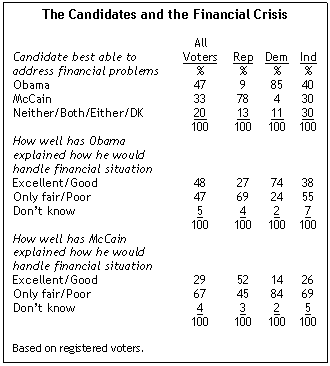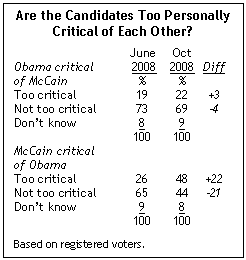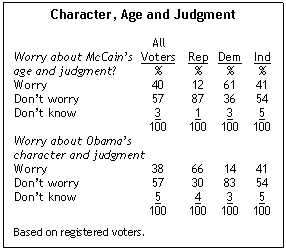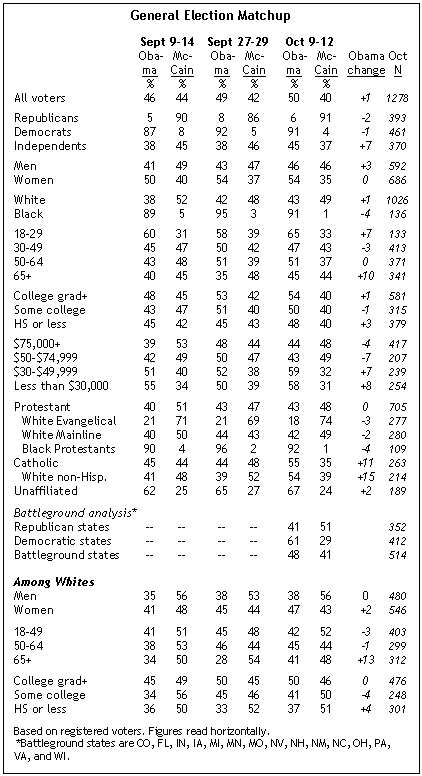
With two well-received debate performances behind him and the public focused on the economy, Barack Obama holds a solid 10-point lead (50% to 40%) over John McCain, one of his largest advantages in Pew polls this year. Among those most likely to vote on Nov. 4, Obama’s lead is seven points (49% to 42%). Just one month ago, following the party conventions, the race was tied among likely voters, 46% each.
Voters continue to express greater confidence in Obama to address the current problems with financial institutions and markets. But neither candidate receives particularly high marks for the specifics of what he has said about the economic crisis. A sizeable plurality (47%) says Obama is the candidate best able to deal with the problems in financial institutions and markets (33% say McCain would be best). Among independent voters, Obama holds a smaller 40%-30% advantage on this question.
But neither candidate is seen by a majority as having

laid out a clear plan for dealing with the situation. Voters are divided on whether Obama has done so: 48% say he has done an excellent or good job explaining what he would do, while 47% rate him as only fair or poor in doing so. But McCain fares worse. Just 29% say he has done an excellent or good job in explaining his ideas, while fully two-thirds (67%) say he has done only a fair or poor job in this respect.
Obama also has an advantage in voter assessments of the tone of the campaign. Nearly half (48%) see McCain as too personally critical of Obama. By comparison, just 22% see Obama as too critical of McCain. Even among McCain’s own voters, nearly one in five (19%) think he has been too critical of Obama. Fewer Obama voters (13%) think their candidate has been too hard on McCain. Perceptions about the campaign McCain is running are starkly different from what they were in June, when just 26% said he had been too personally critical of Obama. In contrast, the percentage bel ieving that Obama has been too negative is nearly unchanged since June.

The poll addressed public reaction to two of the negative themes in the campaign – McCain’s character question (“Who is the real Barack Obama?”) and Obama’s charge that McCain has been “erratic,” which some observers have seen as a reference to McCain’s age. Comparable majorities of 57% say they do not worry about Obama’s personal character and judgment, or about McCain’s age and judgment. (Forty percent say they do worry about McCain’s age and judgment, and 38% worry about Obama’s character and judgment.)
Since Pew’s last poll, conducted in late September, Obama has taken the lead among white non-Hispanic Catholics. He continues to dominate John McCain among his core support groups, including a nearly two-to-one lead among young voters (65%-33%), a 19-point advantage among women (54%-35%), and a whopping 91%-1% advantage among African Americans. He has now pulled even among voters ages 65 and older, gaining 10 points among this group since last month.
There is also a somewhat greater correspondence between income and voter preferences than there was two weeks ago. Obama gained support among voters with annual incomes under $50,000 while dropping slightly among those making $50,000 or more.


McCain holds a very large lead among white evangelicals (74%-18%) but does not have a clear lead among any other religious group. Obama has struggled among white Catholics but now holds a significant lead of 54% to 39% among this key swing group.
As Obama’s margin has increased so has his advantage in strong support. The percentage of voters overall who say they support him “strongly” now stands at 36%; thus he is receiving strong support from nearly three-fourths of his voters (71%). By contrast, McCain has trailed Obama in strong support throughout the campaign: just 21% of voters overall are supporting McCain strongly. About half of McCain’s own backers (53%) say they support him strongly, which is largely unchanged since the GOP convention.
One-in-Four Still Swinging

About one-in-four registered voters (24%) remain in the swing vote category, with 10% completely undecided and the remainder either leaning to a candidate or saying they might change their mind before the election. The size of the swing vote is somewhat larger than at a comparable point in the campaign four years ago and about the same size as in mid-October 2000, when – as now – there was no incumbent running.
Meanwhile, Obama has a sizeable advantage among those who express certainty about their choice: 42% of voters are classified as certain to vote for him, compared with 34% certain to vote for McCain.

McCain has solidified his support among conservative Republicans, with 91% now saying they are certain to vote for him (up from just 79% last month). But he has made no progress in cementing the votes of more moderate Republicans; only 61% of moderate and liberal Republicans are classified as solidly behind McCain. By contrast, 81% of conservative and moderate Democrats are certain to vote for Obama, as are 92% of liberal Democrats.
Independents remain unsettled, with 43% still classified as swing voters, the same as last month. About one-third (32%) say they are certain to vote for McCain, and one-quarter (25%) are certain to vote for Obama.
Whither the Swing Vote?

There are few clear clues as to how swing voters might break as they reach decisions about how – and whether – to vote. Among swing voters, more are leaning or weakly committed to Obama (35%) than to McCain (25%), but 40% are completely undecided.
Swing voters are unimpressed by the economic plans put forth by both candidates. A 53% majority declines to choose between the candidates when asked which one could best address the current financial problems. Among those willing to express a preference, more pick Obama (31% overall) than McCain (16%). Majorities of swing voters give both candidates low ratings on how well they have explained their plans.
Swing voters do see a difference in how the candidates are campaigning. As with voters overall, far more swing voters see McCain as too personally critical of Obama (44%) than say the same about the Democrat’s criticism of his opponent (23%).




